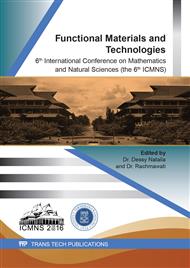[1]
H.M.R. Hoffmann, J. Frackenpohl, Recent advances in Cinchona alkaloid chemistry. European J. Org. Chem. (2004) 4293–4312.
DOI: 10.1002/ejoc.200400294
Google Scholar
[2]
G. Stork, D. Niu, A. Fujimoto, E.R. Koft, J.M. Balkovec, J.R. Tata, G.R. Dake, The First Stereoselective Total Synthesis of Quinine. J. Am. Chem. Soc. 123 (2001) 3239–3242.
DOI: 10.1021/ja004325r
Google Scholar
[3]
I.T. Raheem, S.N. Goodman, E.N. Jacobsen, Catalytic Asymmetric Total Syntheses of Quinine and Quinidine. J. Am. Chem. Soc. 126 (2004) 706–707.
DOI: 10.1021/ja039550y
Google Scholar
[4]
J. Igarashi, M. Katsukawa, Y. Wang, H.P. Acharya, Stereocontrolled synthesis of quinine and quinidine. Tetrahedron Lett. 45 (2004) 3783–3786.
DOI: 10.1016/j.tetlet.2004.03.085
Google Scholar
[5]
S. France, D.J. Guerin, S.J. Miller, T. Lectka, Nucleophilic Chiral Amines as Catalysts in Asymmetric Synthesis. Chem. Rev. 103 (2003) 2985–3012.
DOI: 10.1021/cr020061a
Google Scholar
[6]
W. Zhao, C. Qu, L. Yang, Y. Cui, Chitosan ‐ supported cinchonine as an efficient organocatalyst for direct asymmetric aldol reaction in water. Chinese J. Catal. 36 (2015) 367–371.
DOI: 10.1016/s1872-2067(14)60248-5
Google Scholar
[7]
D.F. Taber, J.C. Amedio, Y.K. Patel, Preparation of β-Keto Esters by 4-DMAP-Catalyzed Ester Exchange. J. Org. Chem. 50 (1985) 3618–3619.
DOI: 10.1021/jo00219a035
Google Scholar
[8]
D. Scebach, A. Thaler, D. Blaser, S.Y. Ko, Transesterifications with 1,8‐Diazabicyclo[5.4.0]undec‐7‐ene/Lithium Bromide (DBU/LiBr) – Also Applicable to Cleavage of Peptides from Resins in Merrifleld Syntheses. Helv. Chim. Acta 74 (1991) 1102–1118.
DOI: 10.1002/hlca.19910740520
Google Scholar
[9]
H. Yamaguchi, Y. Fujiwara, Y. Minoura, Transesterification of Poly (methy1 acrylate) with Optically Active Alcohols. Die Makromol. Chemie 175 (1974) 7–16.
Google Scholar
[10]
R. Singha, J.K. Ray, Selective acetylation of primary alcohols by ethyl acetate. Tetrahedron Lett. 57 (2016) 5395–5398.
DOI: 10.1016/j.tetlet.2016.10.088
Google Scholar
[11]
D. Seebach, E. Hungerbuehler, R. Naef, P. Schnurrenberger, B. Weidmann, M. Züger, Titanate-Mediated Transesterification with Functionalized Substrates. Synthesis 13 (1982) 138–141.
DOI: 10.1055/s-1982-29718
Google Scholar
[12]
E.A. Mensah, L. Earl, Mild and highly efficient copper(I) inspired acylation of alcohols and polyols. Catalysts 7 (2017).
DOI: 10.3390/catal7010033
Google Scholar
[13]
S. Magens, M. Ertelt, A. Jatsch, B. Plietker, A nucleophilic Fe catalyst for transesterifications under neutral conditions. Org. Lett. 10 (2008) 53–56.
DOI: 10.1021/ol702580a
Google Scholar
[14]
D. Nakatake, R. Yazaki, T. Ohshima, Chemoselective Transesterification of Acrylate Derivatives for Functionalized Monomer Synthesis Using a Hard Zinc Alkoxide. 1–5.
DOI: 10.1002/ejoc.201600737
Google Scholar
[15]
T. Ohshima, Development of tetranuclear zinc cluster-catalyzed environmentally friendly reactions and mechanistic studies. Chem. Pharm. Bull. 64 (2016) 523–539.
DOI: 10.1248/cpb.c16-00028
Google Scholar
[16]
F.F.M. de Silva, D.A. Ferreira, F.J.Q. Monte, T.L.G. de Lemos, Synthesis of Chiral Esters and Alcohols via Enantioselective Esterification with Citrus aurantium Peels as Biocatalyst. Ind. Crops Prod. 96 (2017) 23-29.
DOI: 10.1016/j.indcrop.2016.11.013
Google Scholar
[17]
A.K. Banerjee, W. Vera, H. Mora, M.S. Laya, L. Bedoya, E.V. Cabrera, Iodine in organic synthesis. J. Sci. Ind. Res. 65 (2006) 299–308.
DOI: 10.1002/chin.200633282
Google Scholar
[18]
M.S. Yusubov, V.V. Zhdankin, Iodine catalysis : A green alternative to transition metals in organic chemistry and technology. Resour. Technol. 1 (2015) 49–67.
DOI: 10.1016/j.reffit.2015.06.001
Google Scholar
[19]
A. Biswas, G.S. Selling, R.L. Shogren, J.L. Willet, C.M. Buchanan, H.N. Cheng, Iodine-catalyzed esterification of polysaccharides. Chim. Oggi 27 (2009) 33–35.
Google Scholar
[20]
M. Jereb, D. Vražič, M. Zupan, Dual behavior of alcohols in iodine-catalyzed esterification under solvent-free reaction conditions. Tetrahedron Lett. 50 (2009) 2347–2352.
DOI: 10.1016/j.tetlet.2009.02.224
Google Scholar
[21]
H. Li, W. Xie, Transesterification of soybean oil to biodiesel with Zn/I2 catalyst. Catal. Letters 107 (2006) 25–30.
DOI: 10.1007/s10562-005-9727-9
Google Scholar


